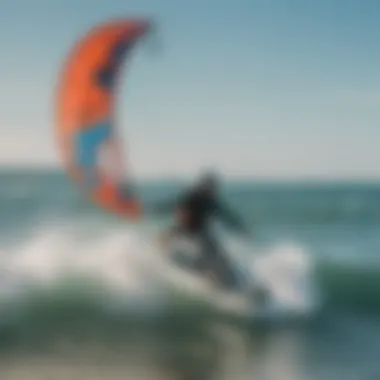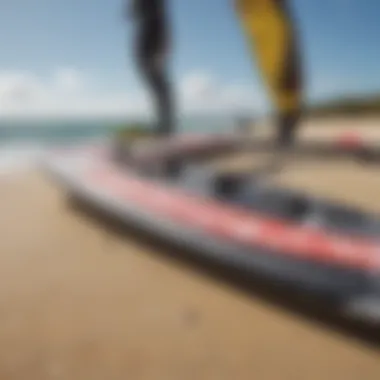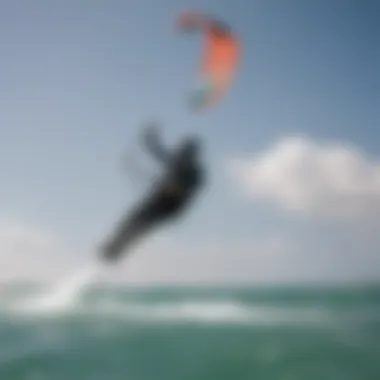Unlocking the Secrets of Optimal Kite Sizes for Unparalleled Kitesurfing and Kiteboarding


Equipment Reviews
When delving into the world of kitesurfing and kiteboarding, understanding the nuances of equipment is paramount. Kites stand out as the fundamental gear shaping your experience. With various shapes, sizes, materials, and brands available, familiarizing yourself with this array is crucial. Moving on to boards, whether twintips or directional boards, each design uniquely impacts your riding style. Analyzing the construction and the compatibility with your skill level becomes pivotal. Moreover, diving into accessories like harnesses, lines, pumps, and safety gear enhances your safety and performance.
Kites: Exploring kite models reveals a realm of innovation and functionality. Each model boasts distinct features that cater to different skill levels, wind conditions, and riding styles. Understanding these differences empowers you to make informed choices based on your preferences and abilities. Additionally, grasping the importance of sizes in relation to wind conditions optimizes your kitesurfing adventures.
Boards: Kiteboarding boards are not mere platforms but precision-crafted tools for your maneuvers. Twintips offer versatility, allowing for different riding stances, while directional boards enhance control in waves. Evaluating design aspects like flex, rocker, concave, and outline influences your performance on the water. Matching the board to your riding style ensures a seamless and enjoyable experience.
Accessories: Navigating the world of kiteboarding accessories enlightens you on the vital role each item plays in your safety and comfort. Harnesses distribute forces, protecting your body during intense maneuvers. Lines serve as the lifeline connecting you to the kite, demanding strength and durability. Each accessory, from pumps to safety gear, contributes to a well-rounded and secure kitesurfing endeavor.
Travel Destinations
Embarking on kitesurfing and kiteboarding escapades transcends the mere act; it's a journey intertwined with exploration and adventure. Discovering popular spots offers a glimpse into iconic destinations renowned for their wind conditions, water clarity, and vibrant kitesurfing culture. Venturing off the beaten path unravels hidden gems that promise secluded sessions and authentic experiences unfiltered by mass tourism.
Popular Spots: Famed kitesurfing locales encompass a spectrum of wonders, from tropical paradises to windy coastal havens. Learning about wind patterns, accommodation options, and local amenities enriches your travel planning. Delving into the vibrant kiteboarding communities thriving in these destinations unveils a world of camaraderie and shared passion.
Off the Beaten Path: Beyond conventional travel guides lie the gems untouched by mainstream crowds. Journeying to offbeat kitesurfing spots presents a chance to savor unspoiled beauty and uninterrupted sessions. Experiencing the allure of secluded beaches and pristine waters adds a sense of exclusivity to your kitesurfing odyssey.
Techniques and Tutorials
Elevating your kitesurfing and kiteboarding skills from novice to expert requires a systematic approach blending theory with practice. Mastering the basics provides a solid foundation, while delving into advanced maneuvers unlocks the thrill of pushing your limits.
Beginner Guides: Initiating your journey with step-by-step tutorials initiates you into the world of kitesurfing. Learning essentials like launching, riding, turning, and landing instills confidence and proficiency. Understanding wind dynamics, kite control, and safety protocols ensures a smooth progression in your kitesurfing endeavors.
Advanced Skills: Elevating your kitesurfing prowess involves honing advanced maneuvers that amplify your adrenaline rush. From perfecting jumps to executing intricate tricks, the realm of wave riding and freestyle techniques beckons to experienced riders. Embracing these challenges promises a constant evolution in your kitesurfing repertoire.


Safety Guidelines
Safeguarding your kitesurfing and kiteboarding excursions hinges on prioritizing safety measures that encompass weather conditions, emergency protocols, and equipment maintenance.
Weather Conditions: Navigating the dynamic realm of wind, currents, tides, and weather patterns demands awareness and adaptability. Monitoring these factors equips you to make informed decisions regarding your sessions. Anticipating changes and adjusting your approach ensures a safe and enjoyable kitesurfing experience.
Emergency Protocols: Equipping yourself with essential safety knowledge shields you from unforeseen mishaps during kitesurfing. Understanding rescue tactics, emergency procedures, and communication protocols guarantees swift and effective response in critical situations. Prioritizing safety over thrill underscores the responsibility that underpins kitesurfing and kiteboarding.
Equipment Maintenance: Upholding the integrity of your equipment through regular checks and maintenance routines safeguards your well-being on the water. Inspecting safety gear for wear and tear, ensuring proper inflation of kites, and securing lines avert potential accidents. Cultivating a culture of vigilance breeds a safe and sustainable kitesurfing community.
Prelude
Kitesurfing and kiteboarding, two exhilarating water sports that blend the thrill of surfing with the freedom of sailing in the air, hinge greatly on the choice of kite size. As we embark on this comprehensive guide to demystifying kite sizes, we delve deep into a realm where precision and knowledge dictate the ultimate kiteboarding experience. This article peels back the layers surrounding kite size selection and unravels the intricate significance it holds for kitesurfing aficionados worldwide. From beginners navigating their first rides to seasoned experts fine-tuning their setups for optimal performance, understanding kite sizes is paramount to mastering the waves and winds. This introduction sheds light on the pivotal role kite size plays in shaping every kiter's journey, from the moment they launch off into the vast azure to the adrenaline-pumping tricks they execute on their boards with finesse and expertise.
Safety Considerations
Safety considerations loom large when it comes to choosing the right kite size for kitesurfing and kiteboarding. Prioritizing safety involves aligning the kite size with wind conditions to mitigate potential risks. Opting for a kite that is too large for the current wind speed can lead to uncontrollable power, increasing the chances of accidents or loss of control. Conversely, using an undersized kite in strong winds may compromise stability and hinder responsiveness, posing safety hazards for the rider. Therefore, emphasizing safety by adhering to recommended kite size guidelines and adjusting equipment to prevailing wind conditions is pivotal for safeguarding against mishaps and ensuring a secure kitesurfing experience.
Factors to Consider
In the realm of kiteboarding and kitesurfing, choosing the right kite size hinges on a multitude of factors that can significantly impact your overall experience. The meticulous consideration of these factors is paramount in optimizing your performance on the water. Your skill level, wind speed, board size, and kite design all play crucial roles in determining the ideal kite size for your sessions.
Rider's Skill Level
The proficiency level of the rider is one of the foundational pillars upon which the selection of the appropriate kite size rests. Novice riders typically benefit from larger kites as they provide greater stability and forgiveness, making it easier to handle gusty or turbulent wind conditions. On the other hand, advanced riders often prefer smaller kites that offer increased maneuverability and speed, catering to their heightened skills and control over the kite's power output.
Wind Speed


Wind speed stands out as a pivotal factor influencing the choice of kite size in kiteboarding and kitesurfing. Light winds necessitate larger kites to generate enough power for propulsion, ensuring smooth movement across the water surface. Conversely, high wind speeds call for smaller kites to prevent overpowering and maintain control over the kite during intense gusts. A nuanced understanding of wind dynamics is essential for matching the kite size effectively to prevailing wind conditions.
Board Size
The dimensions of the board you use in kiteboarding significantly impact the selection of an appropriate kite size. Larger boards typically necessitate larger kites to provide sufficient lift and power, enabling smooth planing and effective navigation through varying wind speeds. Conversely, smaller boards pair well with smaller kites, promoting agile maneuvers and sharper turns due to reduced surface area and drag. Aligning the board size with the chosen kite size is crucial for achieving optimal performance and maneuverability on the water.
Kite Design
The intricate design features of kites play a pivotal role in determining the compatibility between kite size and rider preferences. Different kite models exhibit varying aerodynamic profiles, bridling systems, and aspect ratios that influence performance characteristics such as lift, speed, and responsiveness. Understanding how specific design elements contribute to overall kite behavior empowers riders to make informed decisions when selecting the most suitable kite size for their individual riding style and preferences. Integrating knowledge of kite design nuances enriches the kite selection process, enabling riders to harness the full potential of their equipment for an exhilarating kiteboarding experience.
Understanding Kite Size Charts
Kite size charts play a pivotal role in the realm of kitesurfing and kiteboarding. These charts serve as compasses guiding enthusiasts towards the ideal kite size for their adventures on the water. By scrutinizing a kite size chart diligently, riders can decipher the intricate relationship between kite dimensions and performance outcomes. Each figure and measurement on the chart acts as a roadmap, outlining the nuances of kite sizes available in the market.
Moreover, understanding kite size charts offers clarity on the diverse options accessible to kitesurfers and kiteboarders. It unveils the variations in sizes, ranging from the compact to the expansive, influencing maneuverability, speed, and stability on the waves. Precisely interpreting these charts arms riders with the knowledge essential for optimizing their sporting undertakings, thereby enhancing their overall experience on the water.
In essence, delving into kite size charts is akin to unraveling a cryptic code that holds the key to unlocking the full potential of one's kitesurfing or kiteboarding journey. By comprehending these charts proficiently, enthusiasts can navigate the intricate landscape of kite sizes with finesse and precision, setting the stage for exhilarating escapades amidst the wind and waves.
Kite Size Terminology
To fully grasp the complexities of kite selection, one must first acquaint oneself with the nuanced terminology embedded within the realm of kite sizes. Terms like 'aspect ratio,' 'wingtip sweep,' and 'projected area' may seem cryptic at first glance, but each carries profound significance in determining a kite's performance characteristics.
'A as P' is not just an alphabet sequence but a fundamental metric denoting the area and span of a kite. 'Depower' isn't just a term but a pivotal feature influencing a kite's responsiveness to wind conditions. By embracing these terminologies, riders can engage with kite size charts more meaningfully, deciphering the technical specifications that underpin each kite's design.
This linguistic journey through kite size terminology equips enthusiasts with a deeper understanding of the intricacies of kite construction, aerodynamics, and functionalities, empowering them to make informed choices when selecting the perfect kite for their aquatic adventures.


Decoding Kite Size Recommendations
Deciphering the recommendations outlined within kite size charts is akin to interpreting a covert message designed to optimize one's kitesurfing or kiteboarding performance. These recommendations, often expressed as wind ranges or rider weight brackets, serve as compass points guiding enthusiasts towards the most suitable kite size for prevailing conditions.
By meticulously decoding these recommendations, riders can align their gear with the wind's whims, ensuring optimal maneuverability, stability, and speed on the water. Additionally, understanding these recommendations enables enthusiasts to make informed decisions regarding kite adjustments based on varying wind speeds, ensuring a seamless and safe kitesurfing or kiteboarding experience.
In essence, decoding kite size recommendations is a strategic endeavor that elevates one's prowess in navigating the dynamic elements of wind and water. By heeding these suggestions with acumen and precision, riders can unlock the full potential of their kitesurfing or kiteboarding pursuits, embarking on thrilling escapades with confidence and skill.
Choosing the Right Kite Size
Choosing the right kite size is a crucial element in the realm of kitesurfing and kiteboarding. The significance of selecting the appropriate kite size cannot be overstated as it directly impacts the performance, safety, and overall experience of the rider. A meticulously chosen kite size can enhance maneuverability, speed, and responsiveness, providing the rider with an exhilarating session on the water. On the contrary, an ill-fitting kite size can result in suboptimal performance, difficulty in control, or even safety hazards. Therefore, understanding how to choose the right kite size is fundamental for any kitesurfer or kiteboarder.
Trial and Error Approach
When delving into the process of selecting the right kite size, one approach that riders often undertake is the trial and error method. This method involves testing different kite sizes in varied wind conditions to determine which size works best for individual preferences and riding style. By experimenting with multiple kite sizes, riders can assess how each size influences their performance on the water. Through this iterative process of trial and error, riders can fine-tune their understanding of how different kite sizes affect their maneuvering, speed, and overall experience. While this approach may require time and patience, it is a valuable way for riders to gain insights into their ideal kite size.
Seeking Expert Advice
In the pursuit of selecting the perfect kite size, seeking expert advice can be immensely beneficial for both novice and experienced riders. Consulting with seasoned kitesurfing instructors, professional kiteboarders, or knowledgeable retailers can offer valuable insights into choosing the right kite size based on individual skill level, riding objectives, and prevailing wind conditions. Experts can provide personalized recommendations tailored to a rider's specific needs, guiding them towards making an informed decision on selecting the most suitable kite size. Drawing from the wealth of experience and expertise of kiteboarding professionals can streamline the process of choosing a kite size that aligns with the rider's skillset and aspirations.
Demo Days and Test Rides
Participating in demo days and test rides organized by kite brands and retailers can offer riders a hands-on opportunity to experience and evaluate different kite sizes before making a purchase. These events allow riders to fly various kites, assess their performance across different wind conditions, and gather firsthand feedback on how each kite size handles in the water. By engaging in demo days and test rides, riders can gauge the responsiveness, power, and overall feel of different kite sizes, facilitating informed decision-making when selecting the right kite size for their kitesurfing or kiteboarding endeavors. The practical experience gained from demo days and test rides can provide riders with valuable insights to make a well-informed choice that complements their riding style and preferences.
Finale
Highlighting the imperative facets discussed in the preceding sections, the Conclusion elegantly stitches together the intricate tapestry of kiteboarding wisdom. It serves as a compass directing novices and seasoned enthusiasts alike towards optimal decision-making, fostering a profound appreciation for the meticulous art of kite size determination within the realm of kitesurfing and kiteboarding.
Within this denouement, the Conclusion sows the seeds of discernment, emphasizing the paramount importance of considerations such as rider skill proficiency, variegated wind conditions, board dimensions, and the nuanced designs of kites. It weaves a narrative of empowerment, advocating for a harmonious fusion of practical experience and expert guidance in the pursuit of the perfect kite size.
In a bid to provide tangible value, the Conclusion not only distills the essences of kite size terminology but also casts a radiant light on the process of decoding intricate size recommendations. It transcends mere summary, metamorphosing into a rousing call to action for enthusiasts to embark on a rhapsodic journey towards refined kiteboarding experiences imbued with deliberation and wisdom.
By grounding the insights gleaned throughout the meandering paths of this comprehensive guide, the Conclusion emerges as a cornerstone of edification, enriching the reader's understanding of the meticulous nuances that underpin the transcendental art of kitesurfing and kiteboarding. It stands as an enduring testament to the inexorable allure of the vast azure expanses, beckoning enthusiasts to unfurl their sails and soar into the boundless horizons of kiteboarding prowess.







